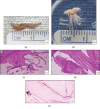Subaortic Membrane Papillary Fibroelastoma
- PMID: 32089895
- PMCID: PMC6977332
- DOI: 10.1155/2020/2586730
Subaortic Membrane Papillary Fibroelastoma
Abstract
A 61-year-old male presented for an annual exam and received a transthoracic echocardiogram (TTE) which revealed a mobile mass arising from a subaortic membrane. Further investigations with a transesophageal echocardiogram (TEE) and cardiac computerized tomography angiography (CTA) confirmed the presence of a mobile 9 mm × 3 mm mass on a subaortic membrane. Cardiothoracic surgery was performed with an open operation removing the mass and subaortic membrane. Upon visual inspection, the mass was likened to a sea anemone and immunohistochemical staining performed pathologically confirmed the diagnosis of cardiac papillary fibroelastoma. This case represents the first reported example of a cardiac papillary fibroelastoma (PFE) arising from a subaortic membrane. Although PFEs are benign cardiac tumors, proper identification and consideration for excision of these lesions may be indicated to prevent thromboembolic complications.
Copyright © 2020 Robyn Bryde et al.
Conflict of interest statement
The authors declare that they have no conflicts of interest.
Figures


References
-
- Val-Bernal J. F., Mayorga M., Garijo M. F., Val D., Nistal J. F. Cardiac papillary fibroelastoma: retrospective clinicopathologic study of 17 tumors with resection at a single institution and literature review. Pathology - Research and Practice. 2013;209(4):208–214. doi: 10.1016/j.prp.2013.02.001. - DOI - PubMed
Publication types
LinkOut - more resources
Full Text Sources

